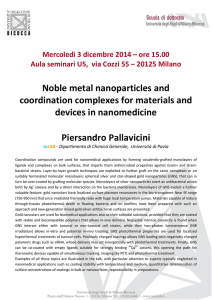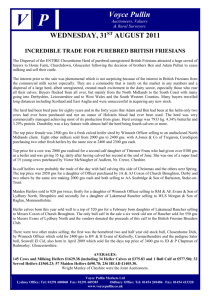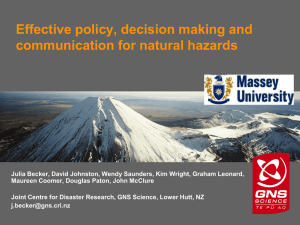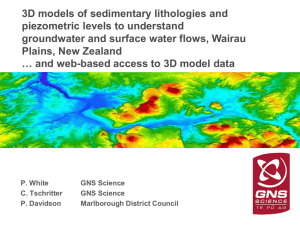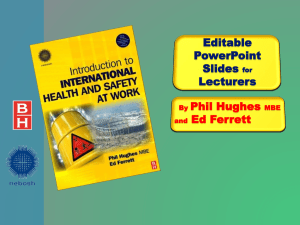GNS Science Dr Philip Barnes
advertisement
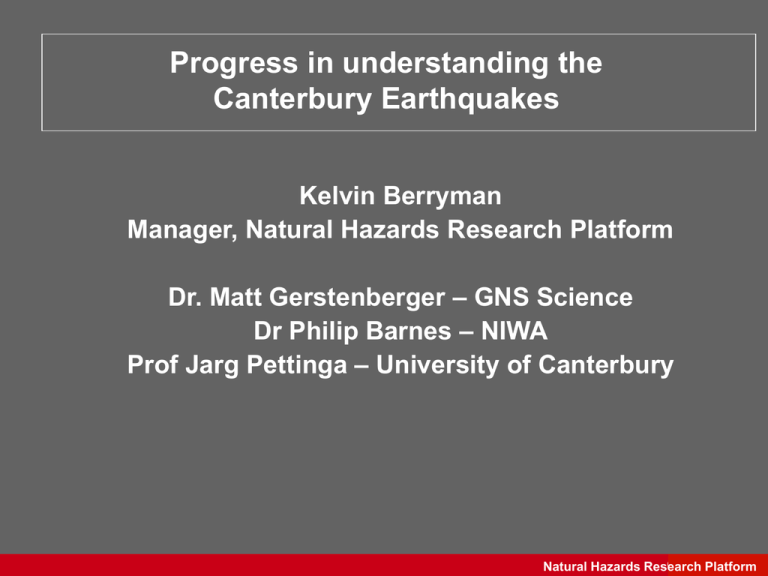
Progress in understanding the Canterbury Earthquakes Kelvin Berryman Manager, Natural Hazards Research Platform Dr. Matt Gerstenberger – GNS Science Dr Philip Barnes – NIWA Prof Jarg Pettinga – University of Canterbury GNS Science Natural Hazards Research Platform GNS Science Aftershock Decay Rate Natural Hazards Research GNS Science Platform Long-term (50yr) Earthquake Rate Forecast • • Increasing time scale • • Used to inform update of building codes Accounts for different earthquake clustering scales Combines four different models Used to estimate probabilities of ground shaking • Short-term clustering model • Days to Year(s) • Medium-term clustering model • Years to decades • Long-term average model • Average earthquake rate since 1960 • NSHM fault model • Longest-term mostly timeindependent Natural Hazards Research Platform Yearly number of earthquakes greater than magnitude 5 from three models GNS Science Extended probabilities of aftershocks and larger events for Canterbury following the 2010 Darfield earthquake from short-term model Magnitude 5.0-5.9 Magnitude 6.0-6.9 Start date & Length 1 week 30 days 1 year 1 week 30 days 1 year May 19th 2011 1 in 8 1 in 3 9 in 10 1 in 100 1 in 20 1 in 4 May 19th 2012 1 in 30 1 in 10 7 in 10 <1 in 100 1 in 100 1 in 10 All earthquakes up to May 16th 2011 were used for these calculations. These forecasts are anticipated to change as the sequence continues to develop. • The occurrence of a larger aftershock will temporarily increase the probabilities • Extended “quiet times” may cause a decrease in the probabilities • Each day a larger event does not occur, the probabilities decrease • Probability of a M6.0 is approximately 10 times that of a 6.9 Natural Hazards Research Platform GNS Science So, if there are going to be further large aftershocks or triggered events, where might they occur……. – this is why we have turned to geophysical surveys to investigate where bedrock faults occur with any evidence of recent movement Natural Hazards Research GNS Science Platform Faulting ..….. and the Earthquake-driven Landscape Canterbury has many active faults that contribute to the earthquake hazard Pettinga et al. (1998) Key Questions: Natural Hazards Research GNS Science Platform Greendale Fault Geology map source: GNS Science QMap series & University of Canterbury Natural Hazards Research GNS Science Platform Onshore seismic reflection lines and aftershock map 1 2 4 6 3 5 Natural Hazards Research GNS Science Platform Line 1 - New Brighton Beach Port Hills fault Depth (m) South 0 North 500 Lyttelton Volcano Paleo-topography 1000 8 km GNS Science Natural Hazards Research Platform Line 2 - Barbadoes Street South Lyttelton railway line Barbadoes Street North 0 Depth (m) channel 500 Lyttelton Volcano Paleo-topography 1000 3.7 km Natural Hazards Research GNS Science Platform Investigating Canterbury subsurface structure Magnetic signature of rocks Near surface variations in rock density • Red lines are known surface active faults • Dots are gravity measurement locations Natural Hazards Research GNS Science Platform Variations in magnetic signature of bedrock • Collection finished last week. • Variations are dominantly due to volcanism (12-6 Ma Banks Peninsula) • Buidings and other man-made features need to be identified GNS Science Variations in bedrock topography Natural Hazards Research GNS Science Platform Multichannel Seismic Reflection data GNS Science Natural Hazards Research Platform Is there active faulting south of the Pegasus Bay Fault? YES, but the faults must have very low vertical slip rates Natural Hazards Research GNS Science Platform GNS Science Natural Hazards Research Platform GNS Science Natural Hazards Research Platform In Summary 1. Faults imaged appear to have extremely low movement rates consistent with very long intervals between major earthquakes 2. There is no evidence of aftershocks stepping onto further offshore faults 3. Further results relating to the seismic profiling southwest and west of the city will become available in a month or so 4. Evidence for low rates of fault movement across the region derived from the subsurface geophysical studies is consistent with assessment that the September and February earthquakes are rare occurrences in Canterbury 5. Forecasts for earthquake activity in the future (1-50 years) has been incorporated into a revision of the building code for the rebuild programme in Canterbury 6. The research teams will be focusing on the integration of the various datasets to provide more confident assessment of earthquake likelihood Natural Hazards Research GNS Science Platform
